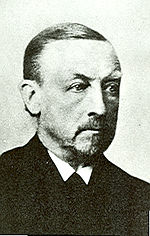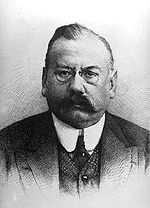Search results
Appearance
There is a page named "Alexander Conze" on Wikipedia
- Alexander Christian Leopold Conze (10 December 1831 – 19 July 1914) was a German archaeologist, who specialized in ancient Greek art. He was a native...5 KB (528 words) - 18:31, 16 March 2023
- at Bonn University; his mother was the daughter of the archeologist Alexander Conze. He gained a doctorate in law and joined the army in 1907. He married...9 KB (1,161 words) - 20:29, 29 October 2023
- These pieces were put on display but were at first largely ignored. Alexander Conze, who was appointed director of the sculpture collection of Berlin's...63 KB (9,267 words) - 02:02, 19 June 2024
- Conze, Alexander (1912). "Stadt und Landschaft" [City and Landscape]. Altertümer von Pergamon. I (1). Berlin: de Gruyter. Volume I 2: Alexander Conze:...79 KB (10,455 words) - 16:11, 13 June 2024
- Room. From 1875, Austrian archaeologists who, under the direction of Alexander Conze, had been excavating the buildings of the Samothrace sanctuary since...42 KB (5,840 words) - 04:17, 29 June 2024
- Werner Conze (December 11, 1910, in Amt Neuhaus – April 1986 in Heidelberg) was a German historian. Georg Iggers refers to him as "one of the most important...24 KB (2,923 words) - 19:27, 3 January 2024
- month, departing on 21 April for the Dardanelles, where she embarked Alexander Conze and members of his archaeological expedition to take them to the island...13 KB (1,672 words) - 22:19, 10 March 2024
- 215f. Socrates and Seneca. in Königliche Museen zu Berlin (ed.), Alexander Conze (foreword): Beschreibung der antiken Skulpturen mit Ausschluss der...4 KB (480 words) - 13:21, 13 August 2023
- since 2009. The Budapest research centre was set up in June 2016. Alexander Conze (1887–1905) Otto Puchstein (1905–1911) Hans Dragendorff (1911–1922)...34 KB (3,603 words) - 21:11, 31 May 2024
- later joined the excavations at Pergamon led by Wilhelm Dörpfeld, Alexander Conze, Theodor Wiegand, and Paul Wolters. Vollmöller also carried out own...7 KB (698 words) - 16:36, 3 October 2023
- He studied archaeology at the University of Vienna as a student of Alexander Conze, and in 1880, received his doctorate at Vienna with Otto Benndorf as...2 KB (229 words) - 14:00, 4 October 2023
- Callenberg Georg Cantor Martin Chemnitz Johannes Clajus Hermann Cohen Alexander Conze Valerius Cordus Caspar Cruciger the Younger Caspar Cruciger the Elder...7 KB (703 words) - 19:34, 12 June 2024
- director of the Berlin Sculpture Museum and financial support from Alexander Conze, as well as the official permits from the Ottoman government, to start...8 KB (1,002 words) - 19:07, 4 February 2024
- 7 May 1853 in Steyr. He studied at the University of Vienna under Alexander Conze and Moritz Thausing. In 1879 he received a position at the k.k. Österreichisches...4 KB (505 words) - 07:42, 30 May 2024
- collaboration with Hubert Knackfuß on the Delphinion in Miletus and with Alexander Conze on the palaces of Pergamon. with Panagiotis Kavvadias: Die Ausgrabung...6 KB (509 words) - 09:53, 4 May 2024
- des Thraseas und der Euandria" in Königliche Museen zu Berlin (Ed.), Alexander Conze, Beschreibung der antiken Skulpturen mit Ausschluss der pergamenischen...3 KB (425 words) - 21:47, 17 February 2024
- the last two scholars long overwhelmed the alternative opinion of Alexander Conze who, using Cavallari's illustrations, first made the connection between...12 KB (1,799 words) - 14:36, 3 August 2023
- Mediterranean, starting with the ruins of Olympia. In 1878 Carl Humann and Alexander Conze began excavations in Pergamon, which brought the museum its most famous...20 KB (2,864 words) - 21:15, 2 September 2023
- Göttingen 1868–1870) Georg Bühler — Scholar of Indian languages and law Alexander Conze — Archaeology — (Student, Privatdozent) Karl Deichgräber — Philology...22 KB (1,718 words) - 19:53, 24 May 2024
- Alexander Conze (1831–1914), he took part in the second Austrian archaeological expedition to Samothrace (1875). Two years later, he succeeded Conze as...3 KB (314 words) - 02:43, 26 January 2024
- Biographie, 1875, &c., xxv. 207; Preussische Jahrbücher, 1870 (art. by A. Conze), xxvi. 83–103; Royal Academy Exhibition Catalogues, 1782–88.] R. E. G.
- tradition have influenced gnosticism? The British scholar of Buddhism, Edward Conze, suggests that it had. Trade routes between the Greco-Roman world and the














